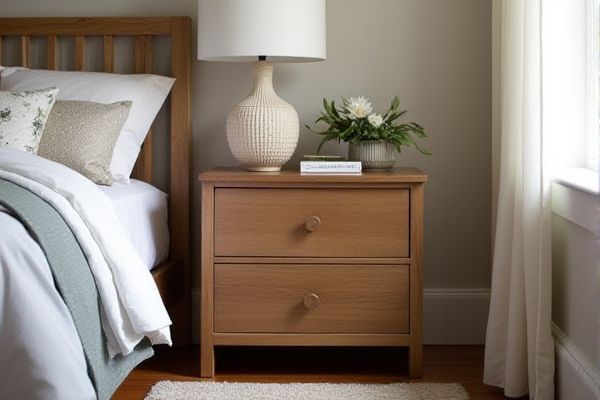
Choosing between a two-drawer nightstand and a three-drawer nightstand depends on your storage needs and bedroom space, as two drawers offer a compact solution while three drawers provide extra organization options. Explore the rest of this article to determine which nightstand best complements your bedroom setup and lifestyle.
Table of Comparison
| Feature | Two-Drawer Nightstand | Three-Drawer Nightstand |
|---|---|---|
| Storage Capacity | Moderate, 2 drawers for essentials | High, 3 drawers for more organization |
| Size | Compact, fits smaller spaces | Larger footprint, needs more room |
| Accessibility | Quick access with fewer drawers | More segmented storage, slightly slower access |
| Cost | Generally lower price | Usually higher price due to more materials |
| Best For | Minimalists, small bedrooms | Those needing more storage, larger rooms |
Key Differences Between Two-Drawer and Three-Drawer Nightstands
Two-drawer nightstands typically offer a more compact design ideal for smaller bedrooms or minimal storage needs, providing easy access to essential items like books and personal electronics. Three-drawer nightstands, on the other hand, deliver increased storage capacity, perfect for organizing multiple belongings such as clothing, accessories, and bedside essentials in a single unit. The choice between the two often depends on available space and desired functionality, with three-drawer models enhancing organization but occupying more floor area compared to two-drawer options.
Space Requirements and Room Suitability
A two-drawer nightstand typically requires less floor space, making it ideal for smaller bedrooms or rooms with limited available wall area. Three-drawer nightstands offer more storage capacity but demand more room, fitting better in larger bedrooms where additional space can be allocated without overcrowding. Selecting between the two depends on balancing storage needs with the physical dimensions and layout of the bedroom.
Storage Capacity Comparison
A three-drawer nightstand offers increased storage capacity compared to a two-drawer nightstand, making it ideal for organizing more personal items like books, electronics, and accessories. Two-drawer nightstands provide a compact solution suitable for smaller spaces while still offering essential storage for your bedside essentials. Selecting the right option depends on your specific storage needs and available bedroom space.
Design and Aesthetic Variations
Two-drawer nightstands typically offer a minimalist design ideal for smaller spaces, emphasizing sleek lines and compact aesthetics. Three-drawer nightstands provide increased storage while introducing a more substantial presence, often featuring varied drawer sizes for visual interest and enhanced functionality. Both designs accommodate diverse interior styles, from modern to traditional, allowing tailored aesthetic choices based on room dimensions and storage needs.
Functional Benefits of Two-Drawer Nightstands
Two-drawer nightstands offer streamlined storage ideal for keeping essential items like books, glasses, and electronics within easy reach without occupying excessive bedroom space. Their compact design enhances room airflow and simplifies cleaning, making them a practical choice for smaller bedrooms. Efficient organization is achieved by separating frequently used bedside items in the top drawer and less accessed belongings in the bottom, optimizing nighttime convenience.
Practical Advantages of Three-Drawer Nightstands
Three-drawer nightstands provide enhanced storage capacity, allowing you to neatly organize more belongings such as books, electronics, and personal items without cluttering your bedroom. The extra drawer offers a practical advantage for keeping frequently used items within easy reach, improving nighttime convenience and overall room tidiness. This added functionality often makes three-drawer nightstands a more versatile choice for your bedroom needs.
Material and Build Considerations
Two-drawer nightstands typically use lighter materials such as pine or MDF, making them easier to move but potentially less durable than three-drawer models, which often feature hardwoods like oak or walnut for enhanced sturdiness. The build quality in three-drawer nightstands usually emphasizes reinforced drawer slides and thicker panels to support increased storage capacity without compromising stability. Material choice directly affects longevity and maintenance, with hardwood models offering superior resistance to scratches and warping compared to composite or softwood alternatives common in two-drawer designs.
Price Range and Value Analysis
Two-drawer nightstands typically range from $50 to $150, offering economical options suitable for smaller budgets and minimalist storage needs. Three-drawer nightstands generally cost between $100 and $300, providing increased storage capacity and enhanced functionality that justifies the higher investment for users requiring more organization space. Evaluating value depends on individual storage requirements and bedroom size, as three-drawer models offer greater utility while two-drawer options prioritize affordability and compact design.
Choosing the Right Nightstand for Your Bedroom
Two-drawer nightstands offer compact storage ideal for small bedrooms or minimalist designs, providing easy access to essentials like books and electronics. Three-drawer nightstands deliver increased storage capacity suitable for larger bedrooms or those needing organized space for clothing, accessories, and personal items. Selecting the right nightstand depends on available bedroom space, storage needs, and preferred aesthetic to balance functionality and style.
Final Thoughts: Two-Drawer vs Three-Drawer Nightstands
Two-drawer nightstands offer a compact design ideal for minimalists or small bedrooms, providing essential storage without overwhelming the space. Three-drawer nightstands deliver increased organization options and more storage capacity, suitable for those needing to keep various items close at hand. Your choice depends on balancing space constraints with storage needs to match your bedroom layout and personal habits.
 homyna.com
homyna.com